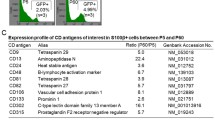Summary
Bovine hypophyseal intermediate lobe tissue and colloid have a particular affinity for adult cells of mesodermal origin. Intermediate lobe materials utilized as an erythropoietic stimulant induces the proliferation of glomerular capillary endothelial cells.
These cells meet the requirements of erythroid precursors for they demonstrate that they belong to a class capable of proliferating, differentiating and undergoing multiple divisions resulting in the formation of colonies of cells belonging to the erythroid series.
The present observations show that intermediate lobe materials simulate erythropoietin(s) and that endothelial cells, when properly stimulated, differentiate along the erythroid cell line.
Similar content being viewed by others
References
Abramowitz, A.: The pituitary control of chromatophores in the dogfish. Amer. Naturalist 73, 208–218 (1930).
Ackerman, G. A.: Histological observations of the oxidative enzyme activity and hemaglobin synthesis in the developing erythrocytic cells of the embryonic liver. Anat. Rec. 144, 239–241 (1962).
Alpen, E., Cranmore, D.: Observations on the regulation of erythropoiesis and on cellular dynamics by Fe59 autoradiography. In the kinetics of cellular proliferation (F. Stohlman, Jr., ed.), p. 290–295. New York and London: Grune & Stratton 1959.
Ban, T., Masai, H., Okada, S., Kaneki, S., Ishino, T., Tanemura, H., Konotsu, T.: Experimental and histological studies on the autonomic centers. Acta anat. Nippon. 31, 64–65 (1956).
Bergmann, W., Lindner, E., Andres, K.: Über Synapsen an endokrinen Epithelzellen und die Definition sekretorischer Neurone, Untersuchungen an Zwischenlappen der Katzenhypophyse. Z. Zellforsch. 77, 282–298 (1967).
Brandner, J.: The intraglandular cleft of the pituitary body and its connections. J. Anat. (Lond.) 66, 202–209 (1931).
Bruce, W., McCulloch, E.: The effect of erythropoietic stimulation on the hemopoietic colony forming cells of mice. Blood 23, 217–232 (1964).
Cronkite, E.: Enigmas underlying the study of hemopoietic cell proliferation. Fed. Proc. 23, 649–661 (1964).
Crow, S., Cushing, H., Homans, S.: Experimental hypophysectoma. Bull. Johns Hopk. Hosp. 21, 127–135 (1910).
Cushing, H., Goetsch, E.: Concerning the secretion of the infundibular lobe of the pituitary body and its presence in the cerebrospinal fluid. Amer. J. Physiol. 27, 60–86 (1910).
De Roberts, E.: Submicroscopic morphology of the synapse. Int. Rev. Cytol. 8, 61–90 (1959).
Dyke, D. van, Garcia, J., Simpson, M., Huff, R., Contopoulos, A., Evans, H.: Maintenance of circulating red cell volume in rats after removal of the posterior and intermediate lobes of the pituitary. Blood 7, 1017–1019 (1952).
Erslev, A.: Erythropoietic function in uremic rabbits. Arch. intern. Med. 101, 407–417 (1958).
—: Erythropoietin in vitro. II. Effect on “stem cells”. Blood 24, 331–342 (1964).
Evans, E., Rosenberg, L., Simpson, M.: Erythropoietic response to calorigenic hormones. Endocrinology 68, 517–532 (1961).
Fujiwara, W.: Experimental removal of the yolk sac in a Rana embryo. Dobutsugaku Zasshi 61, 221–224 (1952).
Galligher, N., McCarthy, J., Lange, R.: Erythropoietin production in uremic rabbits. J. Lab. clin. Med. 57, 281–289 (1961).
Goldwasser, E., Walter, F., Jacobson, L.: Etudies on erythropoiesis. J. Lab. clin. Med. 52, 376–378 (1958).
Halvorsen, S.: Plasma erythropoietin levels following hypothalamic stimulation in the rabbit. Scand. J. clin. Lab. Invest. 13, 564–570 (1961).
—: Effects of ACTH on erythropoiesis in the rabbit. Acta physiol. scand. 58, 30–39 (1963).
— Roh, B., Fisher, J.: Erythropoietin production in nephrectomized and hypophysectomized animals. Amer. J. Physiol. 215, 349–352 (1968).
Herring, P.: The histological appearances of the mammalian pituitary body. Quart. J. exp. Physiol. 121, 281–290 (1908).
Hollyfield, J.: The organ of erythroblasts in Rana pipiens Tadpoles. Develop. Biol. 14, 461–480 (1966).
Howe, A., Maxwell, D.: An electromicroscopic study of the pars intermedia of the pituitary gland in the rat. J. Physiol. (Lond.) 183, 70–76 (1966).
Jacobson, L., Marks, E., Gaston, E., Goldwasser, E.: Studies on erythropoiesis. XI. Reticulocyte response of transfusion induced polycythemic mice to anemic plasma from nephrectomized mice and to plasma from nephrectomized rats exposed ot low oxygen. Blood 14, 635–643 (1959).
— Goldwasser, E., Gurney, C.: Transfusion induced polycythemia as a model for studying factors influencing erythropoiesis. In: Ciba Foundation Symposium on Haemopoiesis (G. E. W. Wolstenholme and M. O'Connor, eds), p. 423–450. London: J. and A. Churchill 1960.
Kurosumi, K., Matsuzawa, T., Shibasaki, S.: Electron microscope studies on the fine structures of the pars nervosa and pars intermedia, and their morphological interrelation in the normal rat hypophysis. Gen. comp. Endocr. 1, 433–452 (1961).
Lewis, D., Miller, J., Mathews, S.: The effects on blood pressure in intravenous injections of extracts of the various anatomical components of the hypophysis. Arch. intern. Med. 7, 785–790 (1911).
Mirand, E., Prentice, T.: Presence of plasma erythropoietin in hypoxic rats with or without kidney(s) and or spleen. Proc. Soc. exp. Biol. 96, 49–51 (1957).
Morley, A., Stohlman, F., Jr.: Erythropoiesis in the dog: The periodie nature of the steady state. Science 165, 1025–1027 (1969).
Naets, J.: The role of the kidney in the production of the erythropoietic factor. Blood 16, 1770–1776 (1960).
Orlic, D., Gordon, A., Rhodin, J.: An ultrastructural study of erythropoietin-induced red cell formation in mouse spleen. J. Ultrastruct. Res. 13, 516–542 (1965).
Patten, B.: Human embryology, 2nd ed., p. 611–621. New York: McGraw Hill 1953.
Rasmussen, A.: The morphology of pars intermedia of the human hypophysis. Endocrinology 13, 129–150 (1928).
Seip, M., Halvorsen, S., Andersen, P., Kuada, B.: Effect on hypothalamic stimulation on erythropoiesis in rabbits. Scand. J. clin. Lab. Invest. 13, 553–563 (1961).
Vollrath, I.: Über die neurosekrektorische Innervation der Andenohypophyse von Tileostiern, insbesondere von Hippocampus coda und Tinca tinca. Z. Zellforsch. 78, 234–260 (1967).
Author information
Authors and Affiliations
Rights and permissions
About this article
Cite this article
Boyd, W.H. Proliferation of glomerular capillary endothelial cells under the influence of hypophyseal intermediate lobe materials. Z. Anat. Entwickl. Gesch. 130, 306–315 (1970). https://doi.org/10.1007/BF00521000
Received:
Issue Date:
DOI: https://doi.org/10.1007/BF00521000




